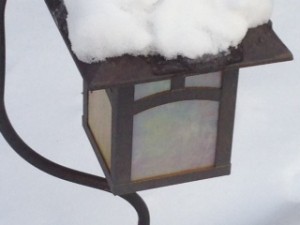 Welcome to our new semi-regular series of posts on Color!
Welcome to our new semi-regular series of posts on Color!
Because color is so fundamental to what we do as fiber artists, Suzy and I will be tackling color one color at a time.
Living in a part of the world that is experiencing winter right now, complete with more snow that usual, I’m very inspired to start this series with white.
I drive through the countryside to go to work five days a week. Often, the ride is very early. Now, the fields are often blanketed with pure, white snow. It is peaceful, quiet, crisp. It seems to possess every hope and possibility to me with its untouched purity.
Because I live in a rural area, when it snows, I often do not go anywhere because the roads are too treacherous and so I sit watching the snow falling from the window. It is the most ideal time to me for the practice of fibery goodness.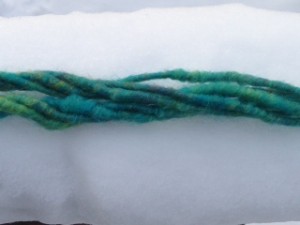
So, that is my current experience of white. But, what of the color’s meaning beyond what I’ve attached to it? Let’s dip back into the Ancient World for a moment to see:
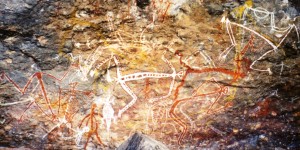 Paleolithic artists selected white as one of the first colors to use made from ground calcite or chalk. Just was we do today, it was sometimes used as a background, sometimes as a highlight in cave paintings.
Paleolithic artists selected white as one of the first colors to use made from ground calcite or chalk. Just was we do today, it was sometimes used as a background, sometimes as a highlight in cave paintings.
The ancient Greeks saw the world in terms of shades of dark and light, so white was essential to their palette. Their paintings contained only four colors: white, red, yellow and black. They used lead white manufactured using a very complicated process.
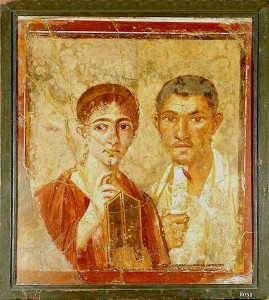 The ancient Romans had two words for white: albus – plain white and candidus – a brighter white. The Latin word “candere” meant to shine, to be bright. Thus, the origin of the words “candle” and “candid” in English.
The ancient Romans had two words for white: albus – plain white and candidus – a brighter white. The Latin word “candere” meant to shine, to be bright. Thus, the origin of the words “candle” and “candid” in English.
In the Middle Ages, artists heavily used white to imbue their Christian-themed art with important symbolism. White was associated with the sacrifice of Christ in the form of a white lamb. White also was the symbolic color of the transfiguration of Christ and artists used their greatest skill to capture the whiteness of Christ’s garments.
 And, of course, it was during this time that the white unicorn, one of our favorite fibery goodness themes, became a common feature in manuscripts, paintings and tapestries. The unicorn image was used to symbolism purity, chastity and grace and could only be captured by a virgin…thus, the rarity!
And, of course, it was during this time that the white unicorn, one of our favorite fibery goodness themes, became a common feature in manuscripts, paintings and tapestries. The unicorn image was used to symbolism purity, chastity and grace and could only be captured by a virgin…thus, the rarity!
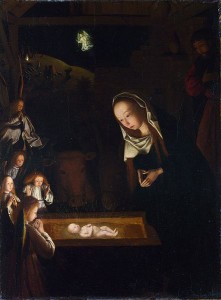 In the Renaissance, the technique known as “chiaroscuro” which heavily relied upon white as part of its effect was termed. This approach early broadened in meaning to cover all strong contrasts in illumination between light and dark areas in art.
In the Renaissance, the technique known as “chiaroscuro” which heavily relied upon white as part of its effect was termed. This approach early broadened in meaning to cover all strong contrasts in illumination between light and dark areas in art.
In other cultures around the world, white has taken on other, much different meanings. For example, in parts of the far East such as China and Korea, white is associated with funerals and morning — a far cry from Western symbolism and the wearing of white dress for a bride!
The use of lead white in art and architecture throughout the ensuing centuries, of course, continued to be heavily featured and relied upon until the early decades of the 20th century when titanium white could be produced from titanium oxide. By mid-century, lead white was finally nearly phased out.
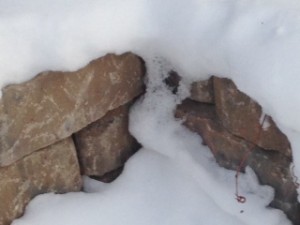 What is actually happening when we experience seeing the color white? A long time ago, maybe even during the Mrs. Mills era, an art teacher explained to me that white is the presence of no color while black is the presence of all colors…true? Doesn’t sound like it based upon this more scientific explanation: White is the color the human eye sees when it senses light which contains all the wavelengths of the visible spectrum.
What is actually happening when we experience seeing the color white? A long time ago, maybe even during the Mrs. Mills era, an art teacher explained to me that white is the presence of no color while black is the presence of all colors…true? Doesn’t sound like it based upon this more scientific explanation: White is the color the human eye sees when it senses light which contains all the wavelengths of the visible spectrum.
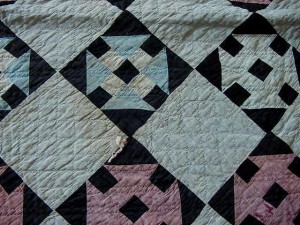 One of my own learning experiences involving white that has been very useful for me was in studying quilting a number of years ago. I was taught to use either white or black in my fabric selection for each quilt. A brilliant example of the effectiveness of this approach can be seen in looking at traditional Amish quilts where no printed fabrics are used. You will see that black and or white is always used. Now, when I look at my woven or knitted pieces, the stronger designs always include this principle. When I have strayed from this, the designs look much weaker to me.
One of my own learning experiences involving white that has been very useful for me was in studying quilting a number of years ago. I was taught to use either white or black in my fabric selection for each quilt. A brilliant example of the effectiveness of this approach can be seen in looking at traditional Amish quilts where no printed fabrics are used. You will see that black and or white is always used. Now, when I look at my woven or knitted pieces, the stronger designs always include this principle. When I have strayed from this, the designs look much weaker to me.
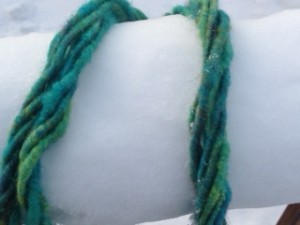 If you are taking part of our Journey to the Golden Fleece course, Ana has created a special Pinterest board related to this post for you this week — look for your weekly email for the link. If you are thinking about joining us with the upcoming February launch, please make sure you are signed up on the mailing list because enrollment will be limited!
If you are taking part of our Journey to the Golden Fleece course, Ana has created a special Pinterest board related to this post for you this week — look for your weekly email for the link. If you are thinking about joining us with the upcoming February launch, please make sure you are signed up on the mailing list because enrollment will be limited!

I remember in an art class at teachers college being shown the colours of the rainbow on a disk being spun round very fast. The resulting colour was white.
A most interesting article, thank you.
Thanks very much, Arlene, for this treatise on White. It’s very interesting and combines lots of fascinating information. Since I study and teach about Eastern tradition and history of Colors in relation to Nature and energy, it might be fun to add to the information you mentioned about the Eastern perspective on White at some point. I love this stuff!
Hi Kitty! I would love it if you wanted to contribute something to be added to a follow up on this topic. You can send me something at thespinartiste@gmail.com – Thanks!!
Since our email about my direction and thoughts on the course, I have decided to try my hand at purpose directed spinning. and to that end I am using the combed top prep of 15.5 micron merino in its all white glory for ALL my yarns of the course. As you said Suzy, it will be very interesting to try different techniques using the same prep wool and color through out for a very technique focused course instead of serendipity.!! looking forward to all the lovely white.
Melisa
Melisa, I think that is an amazing idea. White reflects light so well that you will be able to really see the differences in your design ideas from one yarn to the next. Can’t wait to see all of your work and the final project!
Great article! The way we see color is fascinating. I was fortunate in that my father was an artist; he told me early on that white indicates that presence of all colors, black the absence of them. But I do remember wondering, as a child, how I could be certain other people were seeing the same colors I was seeing.
Beth! I always wondered the same thing as a child…”does my green look like your green?”…:-)